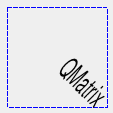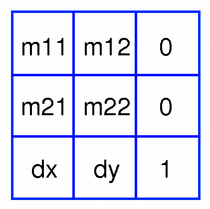 |
CopperSpice API
2.0.0
|
The QMatrix class specifies 2D transformations of a coordinate system. More...
Public Methods | |
| QMatrix () | |
| QMatrix (const QMatrix &other) | |
| QMatrix (qreal m11, qreal m12, qreal m21, qreal m22, qreal dx, qreal dy) | |
| qreal | determinant () const |
| qreal | dx () const |
| qreal | dy () const |
| QMatrix | inverted (bool *invertible=nullptr) const |
| bool | isIdentity () const |
| bool | isInvertible () const |
| qreal | m11 () const |
| qreal | m12 () const |
| qreal | m21 () const |
| qreal | m22 () const |
| QLine | map (const QLine &line) const |
| QLineF | map (const QLineF &line) const |
| QPainterPath | map (const QPainterPath &path) const |
| QPoint | map (const QPoint &point) const |
| QPointF | map (const QPointF &point) const |
| QPolygon | map (const QPolygon &polygon) const |
| QPolygonF | map (const QPolygonF &polygon) const |
| QRegion | map (const QRegion ®ion) const |
| void | map (int x, int y, int *tx, int *ty) const |
| void | map (qreal x, qreal y, qreal *tx, qreal *ty) const |
| QRect | mapRect (const QRect &rect) const |
| QRectF | mapRect (const QRectF &rect) const |
| QPolygon | mapToPolygon (const QRect &rect) const |
| operator QVariant () const | |
| bool | operator!= (const QMatrix &matrix) const |
| QMatrix | operator* (const QMatrix &matrix) const |
| QMatrix & | operator*= (const QMatrix &matrix) |
| QMatrix & | operator= (const QMatrix &other) |
| bool | operator== (const QMatrix &matrix) const |
| void | reset () |
| QMatrix & | rotate (qreal degrees) |
| QMatrix & | scale (qreal sx, qreal sy) |
| void | setMatrix (qreal m11, qreal m12, qreal m21, qreal m22, qreal dx, qreal dy) |
| QMatrix & | shear (qreal sh, qreal sv) |
| QMatrix & | translate (qreal dx, qreal dy) |
Friends | |
| class | QTransform |
Related Functions | |
These are not member functions | |
| QLine | operator* (const QLine &line, const QMatrix &matrix) |
| QLineF | operator* (const QLineF &line, const QMatrix &matrix) |
| QPainterPath | operator* (const QPainterPath &path, const QMatrix &matrix) |
| QPoint | operator* (const QPoint &point, const QMatrix &matrix) |
| QPointF | operator* (const QPointF &point, const QMatrix &matrix) |
| QPolygon | operator* (const QPolygon &polygon, const QMatrix &matrix) |
| QPolygonF | operator* (const QPolygonF &polygon, const QMatrix &matrix) |
| QRegion | operator* (const QRegion ®ion, const QMatrix &matrix) |
| QDataStream & | operator<< (QDataStream &stream, const QMatrix &matrix) |
| QDataStream & | operator>> (QDataStream &stream, QMatrix &matrix) |
| bool | qFuzzyCompare (const QMatrix &m1, const QMatrix &m2) |
Detailed Description
The QMatrix class specifies 2D transformations of a coordinate system.
A matrix specifies how to translate, scale, shear or rotate the coordinate system, and is typically used when rendering graphics. QMatrix, in contrast to QTransform, does not allow perspective transformations. QTransform is the recommended transformation class in CopperSpice.
A QMatrix object can be built using the setMatrix(), scale(), rotate(), translate() and shear() functions. Alternatively, it can be built by applying basic matrix operations. The matrix can also be defined when constructed, and it can be reset to the identity matrix (the default) using the reset() function.
The QMatrix class supports mapping of graphic primitives: A given point, line, polygon, region, or painter path can be mapped to the coordinate system defined by this matrix using the map() function. In case of a rectangle, its coordinates can be transformed using the mapRect() function. A rectangle can also be transformed into a polygon (mapped to the coordinate system defined by this matrix), using the mapToPolygon() function.
QMatrix provides the isIdentity() function which returns true if the matrix is the identity matrix, and the isInvertible() function which returns true if the matrix is non-singular (i.e. AB = BA = I). The inverted() function returns an inverted copy of this matrix if it is invertible (otherwise it returns the identity matrix). In addition, QMatrix provides the determinant() function returning the matrix's determinant.
Finally, the QMatrix class supports matrix multiplication, and objects of the class can be streamed as well as compared.
Rendering Graphics
When rendering graphics, the matrix defines the transformations but the actual transformation is performed by the drawing routines in QPainter.
By default, QPainter operates on the associated device's own coordinate system. The standard coordinate system of a QPaintDevice has its origin located at the top-left position. The x values increase to the right; y values increase downward. For a complete description, refer to the Coordinate System documentation.
QPainter has functions to translate, scale, shear and rotate the coordinate system without using a QMatrix.
 |
Although these functions are very convenient, it can be more efficient to build a QMatrix and call QPainter::setMatrix() if you want to perform more than a single transform operation.
 |
Basic Matrix Operations

A QMatrix object contains a 3 x 3 matrix. The dx and dy elements specify horizontal and vertical translation. The m11 and m22 elements specify horizontal and vertical scaling. And finally, the m21 and m12 elements specify horizontal and vertical shearing.
QMatrix transforms a point in the plane to another point using the following formulas:
The point (x, y) is the original point, and (newX, newY) is the transformed point. (newX, newY) can be transformed back to (x, y) by performing the same operation on the inverted() matrix.
The various matrix elements can be set when constructing the matrix, or by using the setMatrix() function later on. They can also be manipulated using the translate(), rotate(), scale() and shear() methods, The currently set values can be retrieved using the m11(), m12(), m21(), m22(), dx() and dy() methods.
Translation is the simplest transformation. Setting dx and dy will move the coordinate system dx units along the X axis and dy units along the Y axis. Scaling can be done by setting m11 and m22. For example, setting m11 to 2 and m22 to 1.5 will double the height and increase the width by 50%. The identity matrix has m11 and m22 set to 1 (all others are set to 0) mapping a point to itself. Shearing is controlled by m12 and m21. Setting these elements to values different from zero will twist the coordinate system. Rotation is achieved by carefully setting both the shearing factors and the scaling factors.
Here is the combined transformations example using basic matrix operations:
 | void BasicOperations::paintEvent(QPaintEvent *)
{
double pi = 3.14;
double angle = pi/180 * 45.0;
double sinAngle = sin(angle);
double cosAngle = cos(angle);
QMatrix translationMatrix(1, 0, 0, 1, 50.0, 50.0);
QMatrix rotationMatrix(cosAngle, sinAngle, -sinAngle, cosAngle, 0, 0);
QMatrix scalingMatrix(0.5, 0, 0, 1.0, 0, 0);
QMatrix matrix;
matrix = scalingMatrix * rotationMatrix * translationMatrix;
QPainter painter(this);
painter.drawRect(0, 0, 100, 100);
painter.setMatrix(matrix);
painter.drawText(20, 10, "QMatrix");
}
|
- See also
- QPainter, QTransform, Coordinate System
Constructor & Destructor Documentation
| QMatrix::QMatrix | ( | ) |
Constructs a matrix with the elements, m11, m12, m21, m22, dx and dy.
- See also
- setMatrix()
| QMatrix::QMatrix | ( | const QMatrix & | other | ) |
Copy constructs a new QMatrix from other.
Method Documentation
|
inline |
Returns the matrix's determinant.
|
inline |
Returns the horizontal translation factor.
- See also
- translate()
|
inline |
Returns the vertical translation factor.
- See also
- translate()
| QMatrix QMatrix::inverted | ( | bool * | invertible = nullptr | ) | const |
Returns an inverted copy of this matrix.
If the matrix is singular (not invertible), the returned matrix is the identity matrix. If invertible is not a nullptr the value it points to is set to true if the matrix is invertible, otherwise it is set to false.
- See also
- isInvertible()
|
inline |
Returns true if the matrix is the identity matrix, otherwise returns false.
- See also
- reset()
|
inline |
Returns true if the matrix is invertible, otherwise returns false.
- See also
- inverted()
Creates and returns a QLine object that is a copy of the given line, mapped into the coordinate system defined by this matrix. The transformed coordinates are rounded to the nearest integer.
Creates and returns a QLineF object that is a copy of the given line, mapped into the coordinate system defined by this matrix.
| QPainterPath QMatrix::map | ( | const QPainterPath & | path | ) | const |
Creates and returns a QPainterPath object which is a copy of the given path, mapped into the coordinate system defined by this matrix.
Creates and returns a QPoint object that is a copy of the given point, mapped into the coordinate system defined by this matrix. The transformed coordinates are rounded to the nearest integer.
Creates and returns a QPointF object that is a copy of the given point, mapped into the coordinate system defined by this matrix.
Creates and returns a QPolygon object that is a copy of the given polygon, mapped into the coordinate system defined by this matrix. The transformed coordinates are rounded to the nearest integer.
Creates and returns a QPolygonF object that is a copy of the given polygon, mapped into the coordinate system defined by this matrix.
Creates and returns a QRegion object that is a copy of the given region, mapped into the coordinate system defined by this matrix. Calling this method can be rather expensive if rotations or shearing are used.
| void QMatrix::map | ( | int | x, |
| int | y, | ||
| int * | tx, | ||
| int * | ty | ||
| ) | const |
Maps the given coordinates x and y into the coordinate system defined by this matrix. The resulting values are put in tx and ty, respectively. The transformed coordinates are rounded to the nearest integer.
Maps the given coordinates x and y into the coordinate system defined by this matrix. The resulting values are put in *tx and *ty, respectively.
The coordinates are transformed using the following formulas:
The point (x, y) is the original point, and (newX, newY) is the transformed point.
Creates and returns a QRect object that is a copy of the given rect mapped into the coordinate system defined by this matrix. The transformed coordinates are rounded to the nearest integer.
Creates and returns a QRectF object that is a copy of the given rect mapped into the coordinate system defined by this matrix. The rectangle's coordinates are transformed using the following formulas.
If rotation or shearing has been specified, this method returns the bounding rectangle. To retrieve the exact region the given rect maps to, use the mapToPolygon() function instead.
- See also
- mapToPolygon()
Creates and returns a QPolygon representation of the given rect mapped into the coordinate system defined by this matrix. The rectangle's coordinates are transformed using the following formulas.
Polygons and rectangles behave slightly differently when transformed (due to integer rounding), so matrix.map(QPolygon(rect)) is not always the same as matrix.mapToPolygon(rect).
- See also
- mapRect()
| bool QMatrix::operator!= | ( | const QMatrix & | matrix | ) | const |
Returns true if this matrix is not equal to the given matrix, otherwise returns false.
| QMatrix QMatrix::operator* | ( | const QMatrix & | matrix | ) | const |
Returns the result of multiplying this matrix by the given matrix. The matrix multiplication is not commutative, for example: a*b != b*a.
| QMatrix & QMatrix::operator*= | ( | const QMatrix & | matrix | ) |
Returns the result of multiplying this matrix by the given matrix.
| QMatrix & QMatrix::operator= | ( | const QMatrix & | other | ) |
Copy assigns from other and returns a reference to this object.
| bool QMatrix::operator== | ( | const QMatrix & | matrix | ) | const |
Returns true if this matrix is equal to the given matrix, otherwise returns false.
| void QMatrix::reset | ( | ) |
Resets the matrix to an identity matrix, i.e. all elements are set to zero, except m11 and m22 (specifying the scale) which are set to 1.
- See also
- QMatrix(), isIdentity()
| QMatrix & QMatrix::rotate | ( | qreal | degrees | ) |
Rotates the coordinate system the given degrees counterclockwise.
If you apply a QMatrix to a point defined in widget coordinates, the direction of the rotation will be clockwise because the y-axis points downwards.
Returns a reference to the matrix.
- See also
- setMatrix()
Scales the coordinate system by sx horizontally and sy vertically and returns a reference to the matrix.
- See also
- setMatrix()
Sets the matrix elements to the specified values, m11, m12, m21, m22, dx and dy.
This function replaces the previous values. QMatrix provide the translate(), rotate(), scale() and shear() convenience functions to manipulate the various matrix elements based on the currently defined coordinate system.
- See also
- QMatrix()
Shears the coordinate system by sh horizontally and sv vertically, and returns a reference to the matrix.
- See also
- setMatrix()
Moves the coordinate system dx along the x axis and dy along the y axis, and returns a reference to the matrix.
- See also
- setMatrix()
Friends And Related Function Documentation
Equivalent to calling matrix.map(line).
- See also
- QMatrix::map()
Equivalent to calling matrix.map(line).
- See also
- QMatrix::map()
|
related |
Equivalent to calling matrix.map(path).
- See also
- QMatrix::map()
Equivalent to calling matrix.map(point).
- See also
- QMatrix::map()
Equivalent to calling matrix.map(point).
- See also
- QMatrix::map()
Equivalent to calling matrix.map(polygon).
- See also
- QMatrix::map()
Equivalent to calling matrix.map(polygon).
- See also
- QMatrix::map()
Equivalent to calling matrix.map(region).
- See also
- QMatrix::map()
|
related |
Writes the matrix to the stream and returns a reference to the stream.
Refer to Serializing Data Types for additional information.
|
related |
Reads the matrix from the stream and returns a reference to the stream.
Refer to Serializing Data Types for additional information.
|
related |
The qFuzzyCompare function is for comparing two matrices using a fuzziness factor.
Returns true if m1 and m2 are equal, allowing for a small fuzziness factor for floating-point comparisons; false otherwise.


